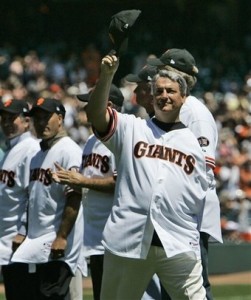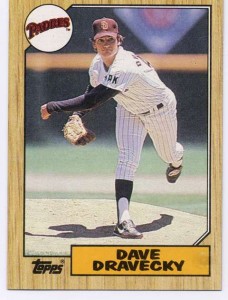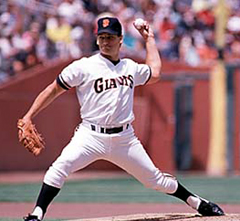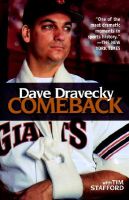Out Reach of Hope, The Dave Dravecky Story
“As time passes, my story fades away.”

The story of Dave Dravecky is one of overcoming personal adversity and hardships.
—Dave Dravecky
Dave Dravecky made his major-league debut with the San Diego Padres on June 15, 1982.
The left-handed Dravecky pitched 105 innings his rookie year, posting an ERA of 2.57.
In Dravecky’s sophomore year, he was named to Major League Baseball’s All-Star game and pitched two scoreless innings while striking out George Brett and Fred Lynn.
In over 25 innings of post season play, Dravecky was used both as a relief pitcher and as a starter. As a relief pitcher in the 1984 World Series for the Padres, Dravecky was flawless, allowing no earned runs in either the NLCS or the World Series, which the Padres eventually lost in five games to the Detroit Tigers.
Dravecky started two games in the 1987 National League Championship Series for the San Francisco Giants. Throwing a complete game, he beat John Tudor of the St. Louis Cardinals in a 5-0 victory in Game Two. Tudor, however, took the rematch in Game Six in a 1-0 heart breaker. St. Louis would defeat the Giants in Game Seven and advance to the World Series.

In eight seasons with the Padres and Giants, Dave Dravecky went 64-57 with a 3.13 ERA. He allowed only one run in 25 innings pitched in postseason play.
Dravecky gave up only one run against the Cards in postseason play, earning him a miniscule post-season ERA of 0.38.
In an eight-year career, Dravecky went 64-57, posting an ERA of 3.13. Appearing in 226 games, he stuck out 558 batters.
Not Hall of Fame numbers, but respectable.
However, it is not his baseball career that Dravecky should be remembered for. It is his incredible courage and amazing victory over cancer.
After being traded to the Giants in 1987, Dravecky pitched an opening day shut-out to kick off the 1988 season. However, it was shortly after that victory that Dravecky noticed something was not right with his pitching arm. The Giant’s placed Dravecky on the disabled list citing stiffness in his left shoulder.
In a subsequent exam, doctor’s found in a lump in Dravecky’s pitching arm, but assured him it was harmless. Suspicious of the diagnosis, Dravecky and his wife Jan returned home to Ohio for more tests.
While sitting in a waiting room, Dave and Jan overheard doctor’s discussing his case in an adjacent office. The finding: a malignant desmoid tumor. Not the best way to find out that you have cancer, not that there is one.
Desmoid tumors develop in fibrous tissue surrounding muscles and other organs. Dravecky’s was located in the deltoid portion of his left shoulder. To save his arm, and his life, it had to be removed.
On the anniversary of their wedding, Oct. 7, 1988, doctors removed the cancerous growth. They also removed most of Dravecky’s deltoid muscle. In an attempt to eradicate all of the cancer cells in Dravecky’s arm, surgeons froze his humerous bone, leaving it fragile. Dravecky was told his pitching days were over.
Dravecky began a furious rehabilitation effort, which resulted in his much-publicized return to the majors on Aug. 10, 1989, against the Cincinnati Reds.

Doctors did not think Dave Dravecky would ever pitch again following cancer surgery in 1988. However, on August 10, 1989 returned to the mound and beat the Cincinnati Reds 4-3.
The game was played at Candlestick Park in San Francisco, and Dravecky did not disappoint.
Receiving standing ovation after standing ovation, Dravecky pitched eight stellar innings and beat the Reds in front of a packed house, 4-3.
The classy Dravecky would give much of the credit to the man he wanted behind the plate, catcher Terry Kennedy. This is what Dravecky had to say about that game:
“It was the most amazing, fun time I ever had playing baseball. I was able to throw the sinker and slider to spots, and that’s how I pitch when I’m on. Terry Kennedy and his knowing how I worked was a big reason for my success that day.”
The comeback, however, would be short lived.
Five days later, in Montreal Stadium, Dravecky’s career would end.
Dravecky went the first three innings by holding the Expos hitless. He chose to ignore the sensation in his arm, as well as his doctor’s advice to stop pitching if he felt anything in the arm.
In the top of the sixth, Dravecky gave up a leadoff home run to Damaso Garcia.
He then hit Andres Galarraga with a pitch and Galarraga advanced to first base. Galarraga would himself be diagnosed with cancer, non-Hodgkin’s lymphoma, 10 years later.
Tim Raines then stepped up to the plate.
In Dravecky’s own words, this is what transpired:
“I concentrated on Raines and threw a pitch. You could hear the popping noise of my arm breaking all over the stadium. I never felt that kind of pain in my life. It felt like my arm was coming off.”
Later that year, the Giants beat the Chicago Cubs in the National League playoffs, and in the obligatory pile-up at the end of the deciding game, Dravecky’s arm was broken again.
Upon examination of the ensuing X-rays, doctors discovered that the cancer had returned.
After several surgeries, and both internal and external radiation treatments, doctors finally conceded the inevitable and on June 18, 1991; they amputated Dravecky’s left shoulder and arm.
As you can imagine, both Dravecky and his wife struggled with the sobering realization that life would never be the same for either of them.
But where one story ends, another begins.
I have shared with you how Dravecky felt on that horrible day in Montreal, but what he kept thinking of was something his friend, teammate, and fellow pitcher, Bob Knepper, had told him earlier:
“God has provided a platform through baseball for you to share his love for those who hurt.”
Dravecky kept going back to this statement turning it over and over in his mind. He had an idea what it meant, but at first he wanted nothing to do with it.
Relying on their faith, Dave and Jan persevered. To help others would now be their main focus in life.

Dravecky has written several motivational books.
The first of Dravecky’s two motivational books about his experience, Comeback, was published in 1990, co-authored by his wife Jan and Ken Gire. When You Can’t Come Back was published two years later.
Comeback was republished as a children’s book in 1992.
In 2004, Dravecky penned a motivational Christian book entitled, Called Up.
Dravecky has been serving as a motivational speaker for the last several years and operates two Web sites. The first, DaveDravecky.com, bears this quote:
“Do not deny the impact your life can have on others.”
The second of the two is Outreach of Hope. Its mission, as stated on the home page, is hope, “Hope for those that hurt.”
I implore you to not let Dravecky’s story be forgotten. He is a true hero and a testament to the human spirit, turning his tragedy into so much hope and help for so many others.
We welcome Blaine Spence as a new contributor to Sports Then and Now.
Hi everyone, – uncovered this web page by accident when looking around the internet this evening, and delighted that I did! I do like the page structure and colorings, but I ought to point out that I’m having trouble when it loads. I’m using Camino 1 internet browser for mac, and the menu block fails to align completely. i am confident I have made use of exactly the same design on a client’s online site, but the menu seems O.k on mine. I imagine the mistake is at this end & I guess it’s time to change!